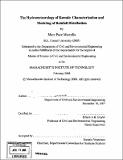The hydrometeorology of Kuwait : characterization and modeling of rainfall distribution
Author(s)
Marcella, Marc Pace
DownloadFull printable version (22.24Mb)
Other Contributors
Massachusetts Institute of Technology. Dept. of Civil and Environmental Engineering.
Advisor
Elfaith A.B. Eltahir.
Terms of use
Metadata
Show full item recordAbstract
This thesis presents a comprehensive study on the hydrometeorology of Kuwait. The spatial, seasonal, and inter annual variability of Kuwait rainfall is discussed based on rain gauge and satellite datasets. It is found that the spatial distribution of Kuwait's annual rainfall features a gradual increase from the southwest to the northeast. Furthermore, Kuwait experiences a distinct rainy season from November to April, with double peaks in January and March. The seasonal variability of rainfall is associated with shifts in the pattern of mid-latitude storm tracks migrating towards the Middle East during the winter and spring seasons. These patterns are characterized using estimates of the spatial correlations of rainfall in Kuwait with the surrounding region. At the interannual timescale, significant correlation is found between the tropical El Nifio-Southern Oscillation and annual rainfall anomalies. Similar correlations are found between mid-latitude rainfall in Europe and rainfall in Kuwait. In addition, a new sub-cloud layer evaporation scheme is incorporated into Regional Climate Model 3 to better simulate the rainfall distribution over Kuwait. The new scheme represents sub-cloud layer evaporation of convective as well as large scale rainfall. These simulations show significant response to the incorporation of sub-cloud layer evaporation where a reduction of nearly 20% in annual rainfall occurs over the region. As a result, the new model simulations of annual rainfall are within 15% of observations. Results also indicate that the interannual variability of rainfall simulated by RegCM3 is sensitive to the specification of boundary conditions. Moreover, with sub-cloud layer evaporation incorporated as well as ERA40 boundary conditions implemented, the model's bias and root mean square error are significantly reduced. Therefore, the model's ability to reproduce observed annual rainfall and the yearly variations of rainfall is greatly improved. Ultimately, the analysis presented here allows for the future assessment of climate variability of Kuwait.
Description
Thesis (S.M.)--Massachusetts Institute of Technology, Dept. of Civil and Environmental Engineering, 2008. Includes bibliographical references (p. 95-103).
Date issued
2008Department
Massachusetts Institute of Technology. Department of Civil and Environmental EngineeringPublisher
Massachusetts Institute of Technology
Keywords
Civil and Environmental Engineering.